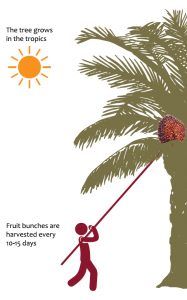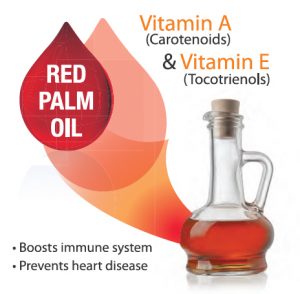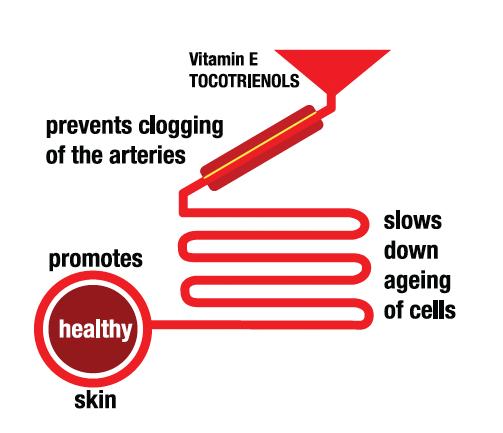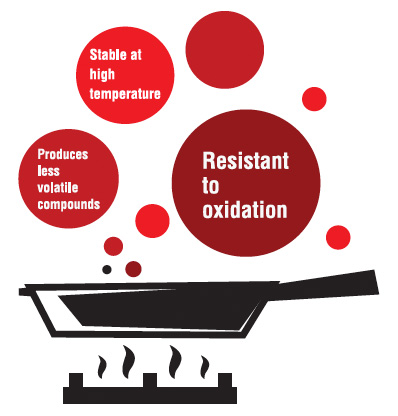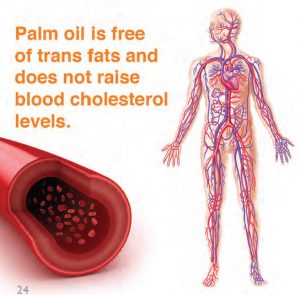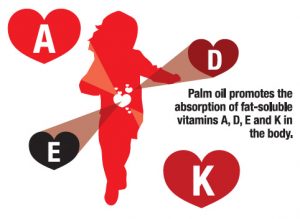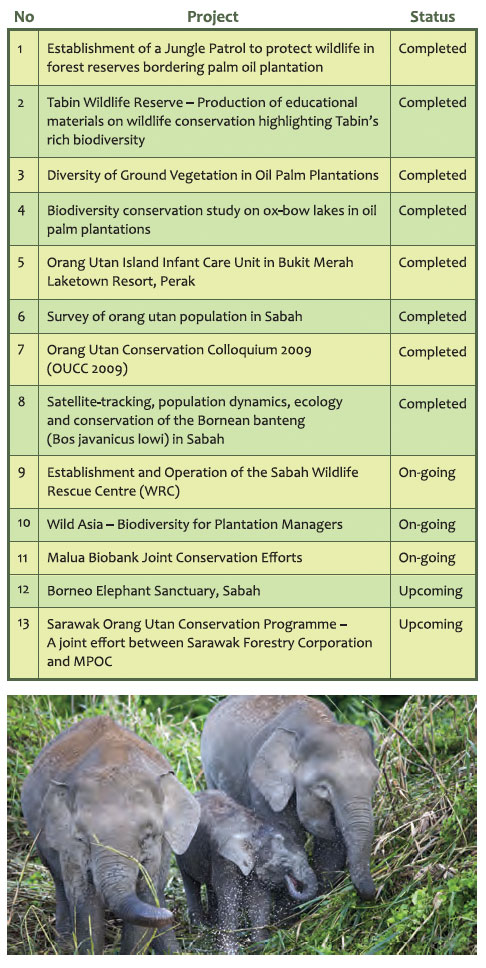FAQs
What is oil palm?
The oil palm (Elaeis guineensis jacq.) is a species of palm that originates from West Africa, in particular the area between Angola and Gambia. It is a perennial, tropical tree crop that starts bearing fruits in large bunches, weighing between 5 to 30kg each, after 30 months of field planting.
The oil palm fruitlets from the bunches (known as fresh fruit bunches) are unique as each produces two types of edible vegetable oil; palm oil from the mesocarp (flesh of the fruit) and palm kernel oil from the kernel (seed). Both are edible oils but with very different chemical compositions, physical properties and applications.
Each fruit bunch will produce 20-25% oil at the mill. For every 10 tonnes of palm oil produced at the mill, 1 tonne of palm kernel oil is produced when the kernel is crushed.
The oil palm keeps producing the fruit bunches until the end of its economic lifespan; between 25 to 30 years. This remarkable agronomic characteristic allows the oil palm to provide a consistent and uninterrupted supply of vegetable oils to meet the ever-increasing global demand.
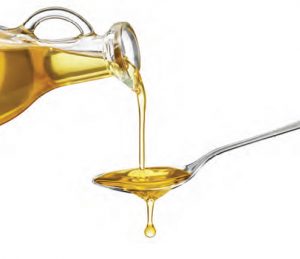 What is palm oil?
What is palm oil?
Palm oil, like olive oil, is a fruit oil. It is the only vegetable oil that contains an equal proportion of unsaturated and saturated fatty acids. It is particularly rich in saturated palmitic acid (44%), and monounsaturated oleic acid (40%). Palm oil is also naturally very stable because of its low content of polyunsaturated fatty acids (10%), in addition to its Vitamin E content.
What are the differences between palm olein, palm stearin and palm super olein?
As palm oil is naturally semi-solid at room temperature (20°C), the liquid portion can be physically separated from the solid portion by fractionation. The liquid fraction is known as palm olein while the solid fraction as palm stearin.
Palm olein is bottled and sold as cooking oil or used in food manufacturing such as instant noodles and fried food products. Palm stearin is used in the formulations of trans fat-free margarine, shortening and vegetable ghee.
Palm olein can be further fractionated to produce palm super olein, which is a more liquid fraction. It can withstand a lower temperature than palm olein before it clouds or solidifies.
Is palm oil similar to palm kernel oil?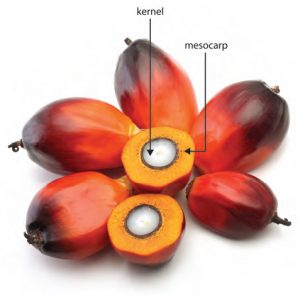
No. Palm oil comes from the mesocarp or flesh of the oil palm fruit while palm kernel oil comes from the kernel or seed. In terms of uses, palm oil is mainly used for edible purposes, while palm kernel oil is generally used for non-edible purposes such as making soaps, cosmetics and detergents. In addition, palm kernel oil has specialised applications in confectionery fats, or cocoa butter substitute (CBS) and cocoa butter equivalent (CBE).
Is palm oil similar to coconut oil?.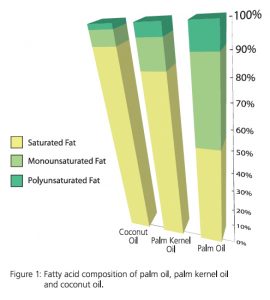
No. It is palm kernel oil that is similar to coconut oil in terms of chemical composition, physical characteristics and uses (Figure 1).
Why does palm olein sometimes turn ‘cloudy’? Is it still safe for consumption?
Palm olein has a ‘cloud point’ of approximately 10ºC. So, whenever the temperature drops to 10ºC, the palm olein molecules crystallise; making the oil appear cloudy.
This is a natural physical transformation of the oil at low temperatures (or in cold climate) and it poses no harmful effect on health. At even lower temperatures, the cloudy oil becomes solid. Indeed, this process is reversible – once the temperature is raised beyond the cloud point, the cloudiness will start to disappear. It is therefore safe to consume palm olein. This is similar to the water-ice phenomenon.
How can palm olein be prevented from becoming ‘cloudy’?
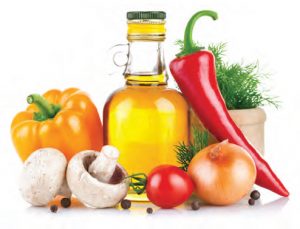
Cloudiness in palm olein can be prevented by lowering its ‘cloud point’ value. One way to do this is by blending palm olein with any polyunsaturated or monounsaturated vegetable oil. The use of monounsaturated super olein with a lower ‘cloud point’ also helps to improve the blend and increase its resistance to cloudiness.
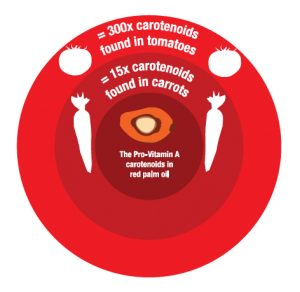 Why are certain palm oil products red in colour?
Why are certain palm oil products red in colour?
Crude palm oil is very rich in plant pigments called carotenoids, which give the oil a naturally distinct orange-red colour. In conventional refining process, all the carotenoids in crude palm oil are removed; giving the refined oil a golden-yellow colour. Thanks to an innovative technology introduced by the Malaysian palm oil industry, the healthful natural carotenoids (along with Vitamin E) in the oil are retained in the refined product marketed as red palm oil.
What is so special about red palm oil?
Red palm oil (RPO) is the only commercially-available vegetable oil that contains substantial amounts of carotenoids (about 550 μg/g) and Vitamin E (600 μg/g) comprising tocotrienols (65%) and alpha-tocopherols (35%).
Some of the carotenoids in RPO are converted to vitamin A in our body; the rest of the carotenoids, together with vitamin E (particularly tocotrienols), play a vital role in advanced nutrition – boosting the immune system, scavenging damaging reactive oxygen species in our body, and are involved in complex mechanisms, which have evolved to protect the body from chronic diseases such as heart disease and cancers of the breast and skin.
How much red palm oil (RPO) does it take to supply the RDA for Vitamin A?
The carotenoid content of RPO is higher than that that of tomatoes’, with beta-carotene (60%) and alphacarotene (30%) forming the two main pro-Vitamin A carotenoids. As a potential source of Vitamin A, RPO provides about 7,000 retinol equivalents (RE) per 100 grams. This means that one teaspoon (6 grams) of RPO will supply the recommended dietary allowance (RDA) of Vitamin A for a child (350-400 RE), while double this amount (12 grams) would supply the RDA for an adult (800 RE).
The body converts whatever Vitamin A it needs (on top of pre-formed Vitamin A from foods of animal origin) from pro-Vitamin A carotenoids, so there is no danger of excess conversion.
What are tocotrienols?
Tocotrienols, like tocopherols, are members of the Vitamin E family. Both can exist in the alpha, beta, gamma or delta forms called isomers.
Vitamin E (both tocotrienols and tocopherols) in food can have any combination of these eight isomers.
Polyunsaturated edible oils are liquids and would need to be first “hardened” by hydrogenation in order that they may attain the semi-solid nature that is needed for manufacture of food products such as margarine, shortening, vegetable ghee, confectionery, and baked products.
During the hydrogenation process carried out at high temperatures, the fatty acids in these oils are transformed into trans fatty acids (TFAs) which are harmful to health. Such hydrogenated fats, containing TFAs, are also referred to as “trans fats”.
What are the dietary sources of tocotrienols?
Palm oil is rich in Vitamin E tocotrienols. Tocotrienols are also found in rice bran oil. Corn oil, soybean oil canola oil and sunflower oil do not contain Vitamin E tocotrienols.
What is so special about tocotrienols?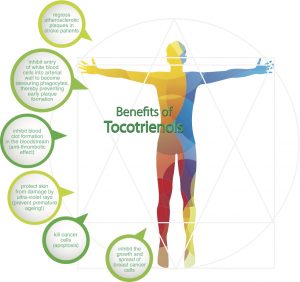
Tocotrienols act as more powerful antioxidants than tocopherols. Scientific research conducted in the United States and elsewhere has demonstrated that tocotrienols have remarkable health effects. Tocotrienols protect against free radical–induced oxidative stress.
Consumption of tocotrienols is associated with cardioprotective effects, skin health, anti-cancer and cancer suppression properties, and neuroprotection.
What are the outstanding characteristics of palm oil?
- Palm oil is one of nature’s richest sources of Vitamin E tocotrienols and pro-Vitamin A carotenoids.
- It is cholesterol-free; studies have shown that palm olein (liquid portion of palm oil) and olive oil have similar beneficial effects on plasma cholesterol levels.
- Additionally, animal and cell-culture studies have found that palm tocotrienols inhibit the growth of certain types of cancer.
- Stable at high temperatures, palm olein is the ideal choice for household and industrial frying as it is less prone to oxidation.
- Palm oil is also odourless and neutral in flavour, thus preserving the natural taste of food.
- Unlike other vegetable oils, palm oil is naturally semi-solid at room temperature; it does not require hydrogenation and is therefore free of trans fats.
Palm oil is one of the 17 edible oils cited by the Food and Agriculture Organisation (FAO)/World Health Organization (WHO) Food Standard under the CODEX Alimentarius Commission Programme.
Why is a stable cooking oil important in frying?
Frying at high temperatures easily oxidises cooking oil and this is harmful to health. It is important to use a stable cooking oil because at least three changes can happen to the oil at high frying temperatures of 140ºC or more:
- the fatty acids of the oil split up to form ‘breakdown’ products;
- attacks by air and moisture form oxidised products; and
- non-volatiles (called polar materials) are formed and accumulated in the frying medium.
The oil oxidises and forms polymers that cause the kitchen walls to be sticky. Additionally, the non-volatiles spoil the quality and taste of the fried food, and pose health risks in the long term.
A stable cooking oil such as palm olein prevents the above from occurring.
Palm olein is stable and its use for frying will not lead to excessive smoking, spattering and foaming. It leaves less gummy residue in the pan after cooking. It has a balanced fatty acid composition (it has a moderate amount of linoleic acid and a small amount of linolenic acid – the two polyunsaturated fatty acids that may be polymerised easily) and a high content of Vitamin E, which is a natural antioxidant.
In order to compete with palm olein as a stable frying oil, many other vegetable oils have to be partially hydrogenated. However, this process is not desirable as it leads to the formation of harmful trans fats in the oils.
What are the effects of oxidised oils?
Animal studies have shown that oxidised oils increase oxidative stress and promote rancidity of the fats in the liver tissues. It has been reported that degraded polyunsaturated frying oils increase risk of hypertension, cancer and heart disease.
Once consumed, how well is palm oil digested?
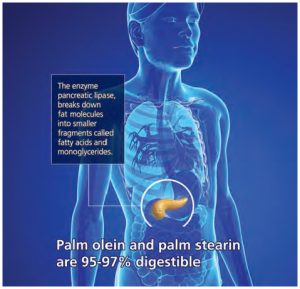
Refined palm oil and its processed fractions, palm olein and palm stearin, are 95-97% digestible, and fall within the digestibility range of 93-99% for edible oils and fats.
Will palm oil consumption raise the blood cholesterol level?
Research conducted in the United States, Europe, Australia and Asia has established that palm oil is neutral to the blood cholesterol level.
It has a unique fat molecule configuration, including a balanced content of unsaturated fatty acids and saturated fatty acids.
Palm oil is also naturally free of trans fats, which have been linked to heart disease.
How are trans fats formed?
Polyunsaturated edible oils are susceptible to attack by air and moisture, especially during frying, leading to the formation of unhealthy oxidised compounds.
Therefore, such edible oils are usually stabilised by partial hydrogenation, which however result in trans-fatty acid formation.
Polyunsaturated edible oils are liquids and need to be first ‘hardened’ through a hydrogenation process to attain the semi-solid nature required especially for the manufacture of food products such as margarine, shortening, vegetable ghee, confectionery and bakery items.
During the hydrogenation process, the fatty acids in these oils are partly transformed into trans fats, which are harmful to health.
How do trans fats harm health?
Research has shown that trans fats are worse than saturated fats in their overall impact on heart health.
Studies conducted on large populations have implicated trans fats as playing a role in chronic diseases such as cancer, Type 2 diabetes and obesity.
In pregnant and lactating women, trans fats can interfere with essential fatty acid metabolism. This could have negative outcomes on foetal development:
- The foetus does not get enough of these essential long-chain polyunsaturated fatty acids (PUFA) from the maternal blood, and may be born with a smaller head circumference.
- The quality of breast milk is adversely affected, depriving the infant of adequate long-chain PUFA nutrition.
Does palm oil contain trans fats?
No. Palm oil does not need hydrogenation as its natural semi-solid properties make it highly suitable in food formulations. Therefore, food products containing palm oil as the sole or main fat ingredient are essentially free of harmful trans fats.
How can I tell whether a food product contains trans fats?
Read the food product labels for words like ‘hydrogenation’ and ‘partial hydrogenation’. These words suggest that the product contains trans fats.
Sometimes the amount of trans fat is either stated on its own or included in the saturated fatty acid count on the food label, in which case a footnote may indicate the amount.
Whenever such information is unavailable, your best bet would be to reach for a palm oil-based product instead. It is essentially free of trans fats.
What are the uses of palm oil?
Palm oil can be used both in its raw state, as well as in its refined form. In Southeast Asia, Africa and parts of Brazil, palm oil is widely used in domestic cooking. In Europe and the United States, palm oil is mainly used in its pale yellow refined form.
Palm oil is a very useful ingredient because of its consistency. It is semi-solid at European and North American room temperatures and is widely used by manufacturers because of its bland taste and the quality of its end-products.
It is also oxidative resistant and has the ability to prolong the shelf-life of manufactured products.
What food products contain palm oil?
Palm oil’s semi-solid properties make it a favourite ingredient of food manufacturers. There are unlimited palm oil fractions for use in any kinds of food application. The oil can be incorporated into a wide variety of food items, including cooking oil, margarine, noodles, shortening, vegetable ghee, bakery products, chocolate, creamer and ice cream. Due to its excellent stability, palm olein is the world’s top choice as frying oil for instant noodles, French fries, potato crisps, doughnuts, snacks, and other fried foods.
The naturally solid nature of palm stearin makes it ideal for formulating solid fats such as vanaspati, margarine, shortening and other bakery fats. As there is no necessity for hydrogenation, palm-based fats are free of trans fats.
Why is palm fat a desirable ingredient in food formulations?
Food manufacturers prefer to use palm fat because of its versatility and diversity in applications. Palm fat is produced through a physical fractionation process and can take different forms. It can be customised for very specific applications, as well as be blended with other fats
or oils for food formulation.
Palm fat contains Vitamin E tocotrienols and tocopherols, and is free of trans fats. It is also currently the most cost-effective and competitively-priced source of fat. Palm fat with various melting profiles is readily available all year round as the oil palm is a perennial crop, and not a seasonal one.
Should a balanced diet contain fat?
Fat is a vital nutrient. It is an important source of energy and supplies essential fatty acids to the body.
Fat is important for the maintenance of healthy skin, to help with the regulation of cholesterol metabolism and as a precursor of prostaglandins, which are hormonelike substances that help regulate some body processes. Dietary fat also aids the body in absorbing Vitamins A, D, E and K
What does palm oil contribute to health?
Palm oil, like other fats, ensures proper growth and enables the body to absorb fat-soluble vitamins. In addition, palm oil helps in keeping up the HDL, or ‘good’, cholesterol levels.
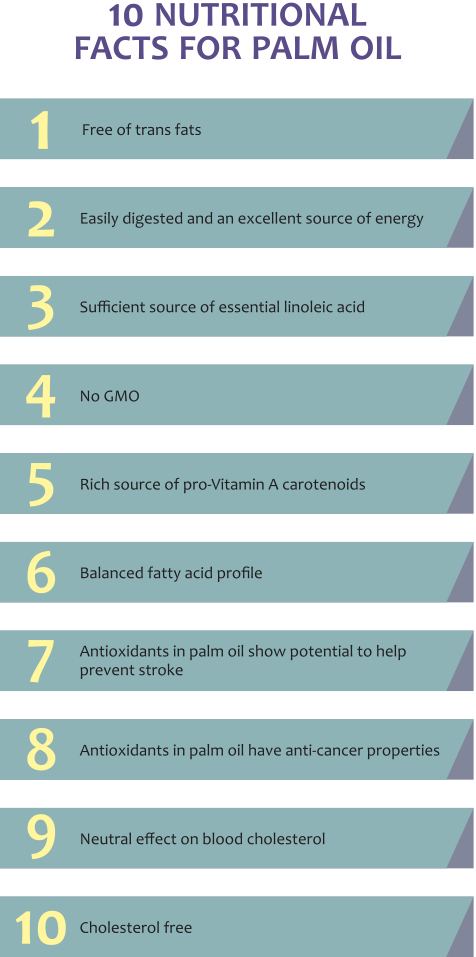
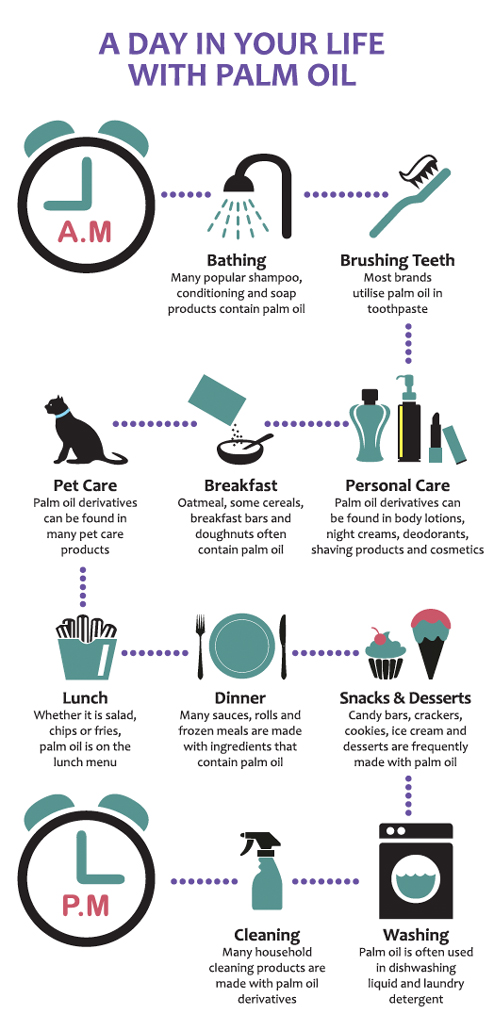
What are palm-based oleochemicals?
Oleochemicals refer to chemicals derived from oils and fats which have been broken down into their constituent fatty acids and glycerol. These products can be further modified to produce various types of oleo-derivatives.
Oleochemicals are often divided into two categories, namely basic oleochemicals and derivatives. Oleochemicals which are sourced from palm oil or palm kernel oil are known as palm-based oleochemicals. Malaysia is the world largest producer of oleochemicals, most of which are palm-based.
Palm-based oleochemicals have properties that are suitable for personal care products including skincare, hair care, oral care and cosmetics. In these products, the oleochemicals and their derivatives provide lubricity, humectants, emulsifiers, emollients, viscosity modifiers, lather improvers, conditioners and sheen.
What are the advantages of palm-based non-food products?
They are natural products, as palm-based raw materials are of renewable vegetable origin. Being vegetable-based, the products are acceptable to adherents of all religions.
Palm-based products have superior biodegradation characteristics compared to petroleum-based surfactants. Cosmetics, for example, have been proven to be of superior quality in terms of their moisturising properties.
What is the history of this successful industry?
The oil palm was introduced by the British colonisers to Malaya as an ornamental plant in the early 1870s. In 1917, Henri Fauconnier, a French rubber and coffee planter, saw its potential as a cash crop and commercially planted oil palm in Tennamaram Estate, in what is known as Bestari Jaya, Selangor.
The demand for palm oil as a lubricant for steam engines and other machinery during the Industrial Revolution in the 19th century encouraged British conglomerates in Malaya to replace rubber with oil palm on their plantations. By 1925, about 3,350 hectares of oil palm had been grown in various parts of Malaya and the acreage increased to about 20,000 hectares by World War II.
In the 1960s, the Malaysian Government began largescale cultivation of oil palm under an agricultural scheme aimed at eradicating poverty and improving the living standards of landless farmers. The refining of crude palm oil started in the 1970s.
By the end of 2004, Malaysia had become the largest producer and exporter of palm oil, accounting for 11% and 26% respectively of the world’s production and export.
Today, the palm oil produced goes into food applications as well as key ingredients in non-food applications such as soaps, candles, lubricants and cosmetics.
Why is Malaysian palm oil ecofriendly?
The Malaysian palm oil industry is one of the most highly organised sectors of any national agricultural systems in the world. The oil palm has been fulfilling sustainability indicators due to its high productivity and efficient carbon sequestration.
Moreover, the second half of the 20th century saw research and development activities taking place along with technological advances. These activities helped raise yields and reduce inputs, thus achieving the goal of maximising oil production from minimal use of land.
The oil palm is the most productive oilseed crop, with an average yield of 4.03 tonnes of oil per hectare, compared to 0.74, 0.61 and 0.41 tonnes of oil respectively from rapeseed, sunflower seed and soybean. The land area for vegetable oil production can be reduced by 5 to 10 times if palm oil replaces other oils.
Although it is one of the two major producers of palm oil, Malaysia utilises less than 18% of its land area of 32.86 million hectares for oil palm cultivation. At least 50% of the land area remains as rainforests, national parks, wildlife sanctuaries and nature reserves.
This green canopy over Malaysia’s land area provides habitats for diverse forms of flora and fauna. Malaysia also does the world a huge service in reducing global warming by holding so much of its land as permanent forest and keeping less than 24% for agriculture, most
of which are tree crops, providing tree cover.
Malaysia’s century-old plantations are professionally managed through good agricultural practices, in compliance with corporate governance and social responsibility. This minimises the impact of plantation activities on the environment and biodiversity. In fact, oil palm plantations in Malaysia are often cited as the best model of tropical agriculture and Malaysian standards are usually referred to as an industry benchmark.
What is MPOC’s main contribution towards conserving wildlife, in fulfilling its corporate social responsibility?
MPOC has established the Malaysian Palm Oil Wildlife Conservation Fund (MPOWCF) with an initial funding of RM20 million in 2006. It has also initiated a number of wildlife and biodiversity conservation programmes, examining highly pertinent issues faced by the industry; from orang utan and elephant conservation, to the country’s first Wildlife Rescue Centre. These initiatives send a strong message to stakeholders that the Malaysian palm oil industry is indeed committed in both word and action to the conservation of the environment and wildlife in Malaysia, while at the same time managing the industry’s activities sustainably.
Highlights of MPOWCF Programmes
Establishment of a Jungle Patrol to protect wildlife in forest reserves bordering oil palm plantation
MPOWCF sponsors an active Jungle Patrol in collaboration with the Sabah Forestry Department, to secure and safeguard wildlife and its habitat at the Tangkulap-Pinangah Forest Reserve in Sabah.
Orang Utan Island Infant Care Unit in Bukit Merah Laketown Resort, Perak
MPOWCF provided funding to establish and operate the Orang Utan Island’s infant care unit in Bukit Merah Lake Resort, Perak. This facility has resulted in the survival and well-being of the orang utans born in captivity at the facility. The facility has also attracted a number of academic research, studying orang utan behavior and nutrition.
Survey of Orang Utan Population in Sabah & Orang Utan Conservation Colloquium (OUCC 2009)
In light of NGO claims that the orang utan population was rapidly declining, MPOWCF commissioned an orang utan population survey in Sabah (in collaboration with Sabah Wildlife Department, BCT and HUTAN, a French NGO). The Sabah orang utan numbering in excess of 11,300 individuals are well protected and these findings were reported at the MPOC initiated OUCC 2009, in the presence of many international orang utan conservation experts.
Sabah Wildlife Rescue Centre (WRC) – A Joint Collaboration between MPOC, Sabah Wildlife Department and Shangri-La Hotels and Resorts
Officially launched in May 2010, the WRC rescues and then translocates distressed wildlife found within the Sabah landscapes. This centre is operated by the Sabah Wildlife Department and is a unique concept contributing towards wildlife conservation through a generous endowment from MPOWCF and partners.
Satellite-tracking, population dynamics, ecology and conservation of the Bornean banteng in Sabah
The programme, by the Danau Girang Field Centre (DGFC) Cardiff University, Sabah Wildlife Department and the French NGO, HUTAN and MPOC studies the population dynamics, ecology and conservation of the Bornean banteng in Sabah through satellite tracking, remote IR camera trapping and molecular analysis.

